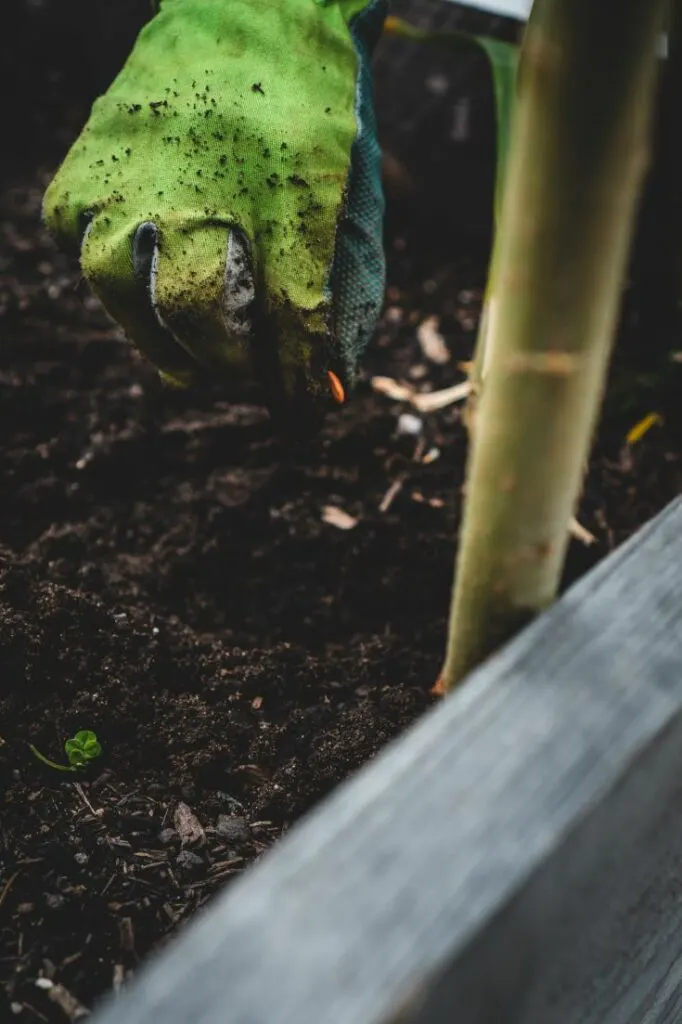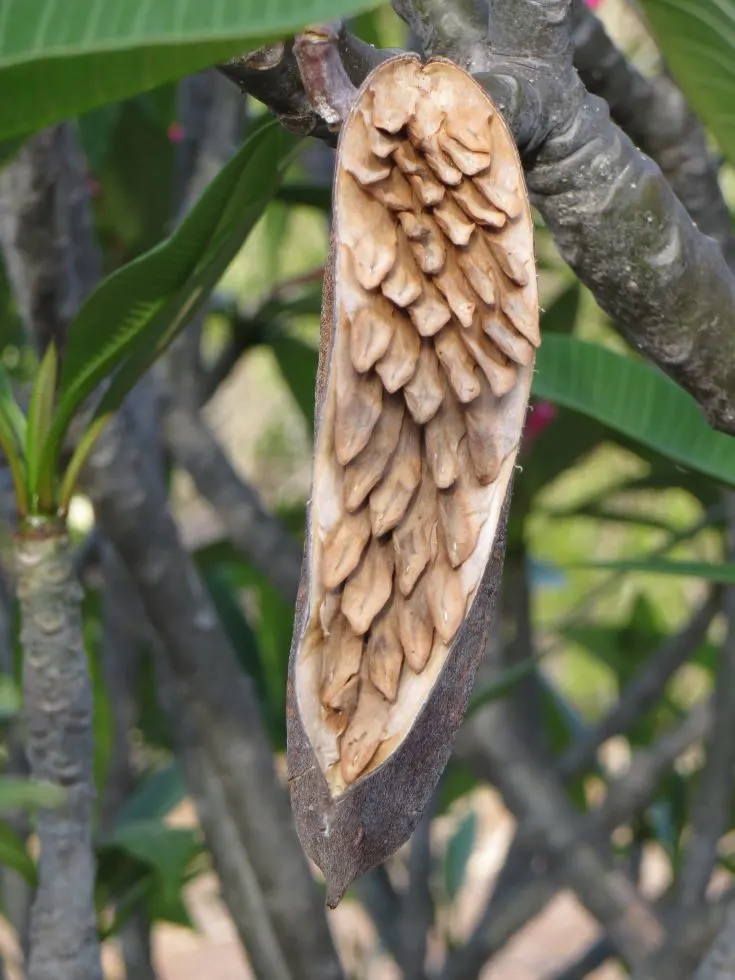Plumeria, or frangipani, is a tropical plant that produces beautiful flowers in various colors. The flowers are bright yellow and have a delicate, fragrant smell.
Plumeria is one of the easiest plants to grow and requires little care.
In this article, we will discuss how to plant Plumeria seeds. Plumeria seeds can be difficult to germinate, but with the right method, it is possible to grow your Plumeria plants from seed.
To start growing Plumeria seeds, you’ll need to select the best ones from your backyard or a local garden center. After you’ve chosen the best Plumeria seeds, it’s time to start growing.
If you’ve never grown any seeds before, don’t worry; it’s pretty easy.
Let’s learn how to plant Plumeria seeds!

Is Growing Plumeria from Seeds Beneficial?
If you want to add a touch of the tropics to your garden, few plants are more exotic than Plumeria.
Also known as frangipani, these beautiful blooms are native to Central and South America. Growing your Plumeria from seeds can be time-consuming, but the process has numerous benefits.
Here are a few good reasons to consider Plumeria seeds over plants:
Save Money
While you can find Plumeria trees for sale at many nurseries, they can be expensive. Growing Plumeria from seeds is a cheaper and more rewarding option.
Feel Better
Not only is growing Plumeria from seeds more affordable, but it’s also more satisfying. Seeing your tree bloom from a tiny seed is an amazing experience. Plus, it’s not as difficult as you might think. You can have your tropical oasis in no time with patience and the right conditions.
Easy Way
Growing blossoms like Plumeria can be a challenging task for beginner gardeners. Seeds are the best option for beginners as it is the easiest way to grow plants.
Quality of Your Choice
Although growing from seeds doesn’t ensure that you will get the exact variety of your choice, the seedlings you nurture at home will give you a healthier plantation.
If you buy Plumeria seeds from a nursery or gardening store, you still can’t be sure if the growers properly took care of the seeds. On the other hand, if you choose to grow your Plumeria with home seeds, you are sure about their quality.
In this way, you control the quality of your future plant.
Seeds at Home
Are you confused because of the many local and online gardening stores and the wide variety of seeds there?
Well, here is the best solution to save you from mental clutter. Grow your Plumeria with home-ready seeds in the easiest way mentioned in this article.
How to Plant Plumeria Seeds? | The Steps!
People love fragrant blooms, so Plumeria is the preferred choice of many garden lovers.
When it comes to growing Plumeria seeds, there are a few things you’ll want to know. Continue reading to learn how to plant Plumeria seeds to enjoy your fresh blooms.
Before we start the process, make sure you have gathered this stuff:
- Containers of your choice
- Some seed-starting mix
- Light source
- Water source
- Seeds
Starting Plumeria from seeds is easy:
1. Take Seeds
Now that you have all the necessary tools, let’s begin the process.
- Cultivars of the Plumeria are sterile and will never produce seeds. In comparison, others have seed pods that look like green beans with seeds that grow into new plants.
- Each seed pod starts forming after the flower’s pollination and contains approximately 20–100 seeds.
- There are several different varieties of Plumeria available, each one being unique. You can grow seeds or buy them from garden stores or online.
- But before you start shopping for seeds, you’ll want to find out which variety is suitable for your climate and needs.
For the next step…

2. Prepare Plumeria Seeds
Here’s how to prepare seeds:
- You can prepare the seeds by soaking them in water for up to 24 hours before planting them in a potting mix. It will help them germinate faster.
- Many people plant the seeds directly into their garden beds without any preparation, but this method doesn’t result in successful germination rates because it isn’t done correctly.
Soaking the seeds first will ensure they sprout easily and quickly after planting.
3. Moisten the Seeds
Now, it’s time to moisten the seeds.
- Fill a small pot or container with lukewarm water.
- Add the frangipani seeds to the water and stir gently.
- Let the seeds soak for 24 hours, stirring occasionally.
If you are not going to plant after 24 hours, then make sure to drain the water and replace it with fresh lukewarm water.
4. Prepare Potting Mix
Once you have soaked or moistened the seeds, now is the time to set the perfect ground for these seedlings.
- Here we are talking about the potting mix to plant these seedlings to grow.
- You can use a ready-made potting mix that might easily be available at your local gardening store or online, or you may make it at home.
Once your potting mix is ready, it’s time to start planting.
5. Plant the Plumeria Seeds
Once your seeds have sprouted, they’re ready for planting.
- Make sure not to plant too early or too late.
- Plumeria are prone to rotting if they’re planted too soon after sowing or not soon enough after sowing (varies with variety).
- To plant the seeds, fill a planting tray with a well-draining potting mix.
- Find a pot large enough to hold your seeds.
- Make tiny holes, insert your finger in the soil, and place the seedlings in these planting holes.
- Gently backfill the holes with soil.
- Important note: Plumeria seeds need plenty of room to grow. A few inches between each seed are good. Crowded seedlings won’t have enough room for sunlight and air to germinate properly.
Now, wait!
6. Wait for Germination
Now that your seeds are planted, it’s time for them to germinate.
- Seeds of the Plumeria plant can take several weeks to germinate.
- Be patient and wait for them to sprout before transplanting them into individual pots.
- Keep the soil moist but not waterlogged during this time.
You can use a wide range of germination steps.
7. Apply Fertilizer
Apply balanced fertilizer if desired. You’ll need to decide whether you’ll be using any fertilizer on your plants during the growing process. It will depend on what type of soil composition you are using.
Related article: 8 Reasons Why Are My Plumeria Leaves Turning Yellow? (With Solutions!)
8. Create a Green House
One of the best ways to get Plumeria seeds to germinate is to create a mini greenhouse effect.
- You can place the seeds in a warm, humid environment.
- One way to create a mini greenhouse effect is to place the tray in a plastic bag with a moist paper towel.
- Another way is to place the seeds in a plastic container. Check on the soil regularly and water accordingly to ensure it doesn’t dry out.
- The third way to create a greenhouse effect is to cover the tray with plastic wrap or a lid and place it in a warm, humid spot.
Both methods should result in healthy seedlings ready to be transplanted into their permanent homes.
9. Water Regularly
It should take about two weeks for little sprouts to poke through the soil if it stays moist. Plant the seedlings in individual pots or outdoors once they reach a height of several inches.
10. Transplant the Swollen Seeds
The Plumeria seeds have germinated, and the seedlings are now about 2–3 inches tall. It’s time to move them to their pots.
- Seedlings are ready to be transplanted when they are large enough to handle, about 6 inches tall. To transplant, carefully remove the seedling from its current pot and loosen the roots.
- Then, plant in the new pot at the same depth it was previously growing.
- Use a well-draining potting mix, and water regularly until the roots are established.
Now you have a new plant in a new pot, and taking care of it is essential.
11. Place the Pot in a Sunny Spot
Be sure to place your new Plumeria plant pots where they will receive full direct sunlight.
- Before moving the baby Plumeria to direct sunlight, acclimate it first by slowly increasing its exposure to direct sunlight each day.
- Start with just an hour or two of direct sunlight.
- Then gradually increase the time each day until the green babies can handle being in full direct sunlight for several hours.
- Plumeria does best in full sun but will tolerate some shade.
- It is best to place the pots in a sunny spot with temperatures above 70 degrees Fahrenheit.
- A heat mat can help provide bottom heat if needed.
That’s all!
Now you know how to plant Plumeria seeds.
If you want a visual guide, check out this video:
What If My Seedlings Do Not Germinate?
If your seedlings do not germinate, it is possible that they were not properly cared for or that the seeds were not viable.
If you followed the instructions and your seedlings still do not germinate, you can try the following:
- Soak the seeds in water for 2–3 days before planting.
- Make sure the planting medium is moist but not soggy.
- Plant the seeds shallowly, about one-fourth inch deep.
- Place the seedlings in a warm and humid location out of direct sunlight.
Now, let’s see how you can take care of your Plumeria.
Plumeria Plant Care
To care for your Plumeria plant, you will need to do the following:
- Make a wateringschedule for your Plumeria plants taking their watering needs, and make sure to water only when the plants are dry. The best time to water your Plumeria is in the morning, so the leaves have time to dry before nightfall.
- Fertilize your Plumeria plant every few weeks. Fertilizing your Plumeria every two weeks will help it grow strong and healthy.
- Deciding how big of an area you want to cover with your Plumeria plants is essential. You can start with a small plant and then expand as needed.
That would be all for today!
Let’s move toward the conclusion.
Conclusion
If you’re looking for a beautiful, fragrant flower to add to your garden, look no further than Plumeria. These tropical plants are easy to grow from seed, and with a bit of patience, you can have them blooming in no time.
In this article, we’ve gone over how to plant Plumeria seeds and get them started on their way to becoming gorgeous flowers.
So, what are you waiting for? Give it a try and enjoy the rewards of your hard work.
Don’t forget to share your efforts in the comment section below!
Regards.
